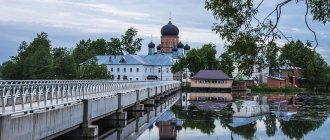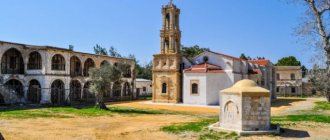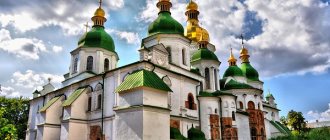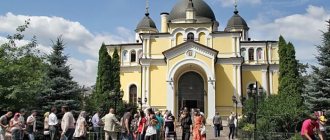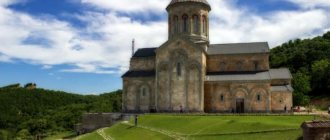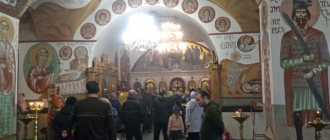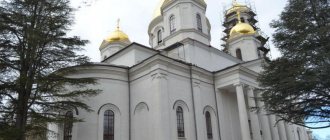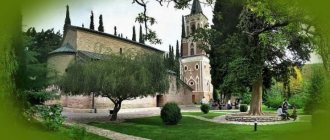The main attraction of Stepantsminda is the Church of St.
Trinity (in Georgian Tsminda Sameba) on a high mountain above the village, and a beautiful view of Kazbek itself. “In the morning, driving past Kazbek, I saw a wonderful sight: white tattered clouds were drawn over the top of the mountain, and a secluded monastery, illuminated by the rays of the sun, seemed to float in the air, carried by the clouds” (A. S. Pushkin “Journey to Arzrum”).
Inspired by the beauty of this place, the poet wrote the poem “Monastery on Kazbek”:
High above the family of mountains, Kazbek, your royal tent Shines with eternal rays. Your monastery is behind the clouds, Like a flying ark in the sky, Soaring, barely visible, above the mountains.
A distant, longed-for shore! There, saying goodbye to the gorge, Rise to the free heights! There, in the sky-high cell, in the neighborhood of God, I should hide!
The silhouette of the Trinity Church standing on a mountain against the backdrop of Kazbek with an icy peak is one of the calling cards of Georgia.
Kazbek and Tsminda Sameba, early morning
The temple on the mountain and the beautiful landscape are depicted in paintings by Russian artists.
N. G. Chernetsov. View of the Trinity Church and Kazbek. Drawing. 1829
I. N. Zankovsky. Mountain landscape. Kazbek
I. N. Zankovsky. Kazbek. (North Ossetian Republican Art Museum named after M. S. Tuganov)
L. F. Lagorio. Mountain landscape. 1888
L. F. Lagorio. Caucasian view. 1889
A. A. Kiselev. In the Caucasus mountains. 1906
A. M. Vasnetsov. Tsminda Sameba Church. Caucasus. 1895 (Museum of Musical Culture named after M.I. Glinka)
V.V. Vereshchagin. Mount Kazbek. 1897 (State Russian Museum)
V.V. Vereshchagin. Entrance door to the church near Kazbek. Etude. 1897 (State Russian Museum)
Monasteries of Kakheti
Old Shuamta Monastery
Old Shuamta Monastery
Kvelatsminda Monastery
Kvelatsminda Monastery in Gurjani
Ikalto Monastery
Ikalto Monastery
Alaverdi Monastery
Alaverdi Monastery
Nekresi Monastery
Nekresi Monastery
Gremi Monastery
Gremi Monastery
New Shuamta Monastery
New Shuamta Monastery
How to get to Kakheti from Tbilisi
It is quite possible to visit all the temples of Kakheti in 1-2 days. In the first case, at a gallop, in the second, at a measured pace. It is best to start by car from Tbilisi. Minibuses run, but they are inconvenient and only to the cities of Telavi, Sighnaghi or Kvareli, respectively. Thus, you must first come to one of the corresponding towns, and then take a taxi - 90 GEL/day. In this case, most likely, it is also impossible to do without an overnight stay. That is, we add another 100-120 lari.
On your own
Minibuses run to Telavi and Kvareli from the Isani metro station. The cost is about 8-10 GEL. It is very, very advisable to arrive early - the route is popular among locals, and places fill up quickly. There is no schedule - departures when full. In general, like everywhere else in Georgia.
You can get to Sighnaghi from the Samgori metro station. This is in Tbilisi. The issue price is 6 GEL. The traffic interval is about two hours, with places the situation is similar - whoever has time gets on.
There is only one minibus running from Telavi to Sighnaghi (and vice versa). It is better to inquire about the departure time the day before. As a method it is very dubious, but in theory it exists.
By taxi
From Tbilisi to Telavi or Sighnaghi back and forth it will cost about 80 or 120 lari, respectively (very much depends on your bargaining ability). In such a scenario, you will have to add the cost of a taxi from the towns to the monasteries themselves, which significantly increases the final cost and is therefore doubtful.
From Tbilisi with a stop in Telavi - monasteries - a stop in Sighnaghi and return to Tbilisi for the whole day costs from 150 GEL and more. Depends greatly on the season. During the season, the price creeps to around 180.
By car
It is better to start from Tbilisi. If you don’t come to Georgia with your own car, then it’s worth renting one. I rented a car in Tbilisi through this site. All GPS coordinates can be taken from the map at the beginning of this article and entered into a navigator or offline maps Google or Maps.me - whichever you like best.
Gergeti
Residents of the village of Gergeti
On the other bank of the Terek River is the village of Gergeti, comfortably located at the foot of the mountain, at an altitude of 1800-1900 meters above sea level, just above Stepantsminda. This is one of the highest mountainous and ancient settlements in Georgia.
According to local legends, the first inhabitants settled in this village back in the 4th century. These were the children of the princess of one of the Kakheti principalities, Sudjeti. After Princess Sudzhi became a monk, her two sons went to these parts to preach Christianity. Having climbed the pass, they saw the snow-covered slopes of Mount Mkinvartsveri (Kazbek). The peak seemed to them like a white swan with its wings spread. The brothers knew Persian. One of the brothers said to the other in Persian: “Look - Gergeti!”, that is, “white swan.” These two brothers founded a settlement at the foot of Kazbek and named it Gergeti. It’s difficult to say how true all this is, at least that’s what local residents say.
There are also guest houses in Gergeti; there are “Guesthaus” signs on the fences and gates.
In general, tourism in Stepantsminda and Gergeti is one of the main sources of income for local residents. Many people set up guest houses, make guest rooms in their own home, or build a separate house in the yard with all the amenities. They also make money as a cab driver - they take tourists up the mountain to the church. There are a lot of tourists in summer, but almost no one in winter, when everything is covered in snow.
Village of Gergeti
Street in Gergeti
Well, what about without cats?!
How to get to Trinity Church?
The road to the Trinity Church goes through the village of Gergeti.
Local residents take tourists up the mountain to the church, mostly in eight-seater Mitsubishi Delicas. It costs 20-25 GEL per person. Prices may vary depending on season, weather and availability. You won’t have to look for someone to take you. In Stepantsminda they will offer their services at every step. Cars are parked in the central square in Stepantsminda and at the turn from the Georgian Military Road to Gergeti.
The entire trip will take about 2 hours. The examination is usually given about an hour. In principle, looking is enough, but if you also want to happily walk around and enjoy the views of the surrounding mountains, then perhaps it’s not enough. If you are traveling only with your group, you can arrange to be picked up at a certain time. Or just go up and walk down. Some tourists only go up, so you can then try to find transport back.
In general, it takes two hours to visit a church if by car, and at least 3 hours if on foot; but in order to take your time and enjoy the walk, it is better to allocate half a day for all this.
Now a good asphalt road with markings and signs has already been completed (it was completed in the fall of 2021). Previously, you could only drive to the church in an SUV, but now you can drive to any car. I think those who make money as drivers are not very happy about this.
If you walk from Stepantsminda, you need to cross the Terek and after the bridge over which the Georgian Military Road passes, turn left to Gergeti. An asphalt road leads through the village towards the mountain.
You need to follow this road almost to the end of the village, to the T-shaped intersection, and here turn left.
Old house in Gergeti
After walking a little more (about 100 m) along the dirt road, you can turn right at the source and continue along the path up the mountain. The climb is quite steep. The trail crosses the road several times, you can follow it, it’s easier, but it takes longer, and cars drive along the road all the time.
There is another way. This trail goes around the mountain on the left. You don’t have to turn off at the source, but go further towards the stone watchtower. In front of the tower the road splits: to the right it is steeper and more difficult, to the left there is a more comfortable path along the stream.
There is such a semi-legal parking lot next to the guest house (which has a green roof). If you are traveling by car and want to climb the mountain on foot, but don’t want to stomp through the streets of Stepantsminda and Gergeti, then you can drive to the guest house under the mountain and leave the car behind the barrier, at the beginning of the trail, it costs 2 GEL.
Behind the tower, both paths join again. Then everything goes up and up, from the T-shaped intersection to the church the distance is only about 1.3 km. However, there are some fairly steep sections. Not very easy, but not too difficult either.
When going up to the church, you need to keep in mind that even if it is hot in the village or on the path leading up the mountain, it can be windy and cold at the top of the mountain, so it is worth bringing a windbreaker and something warm.
In some places something like this
Mountain cows don't care about steep mountains
The peak of Kazbek is visible from the trail
Excursion to Kakheti
For those who do not have a license, are afraid to drive a rented car, or both, there are individual excursions to Kakheti from Tbilisi for one day - this is the best way to, on the one hand, solve the problem of transport, save on an overnight stay and return to Tbilisi on the same day, on the other - to get the maximum pleasure from communicating with a local resident. That's what it's worth going to Georgia for.
There are many good excursions, but personally I am impressed by Mikhail and his very cool author’s tour of Kakheti - you can go away for the whole day to taste wine in the Alazani Valley and have time to explore the original Kakheti monasteries. Everyone is absolutely delighted with Mikhail himself! Just read the reviews.
Group excursions are an option, but, frankly speaking, it’s a compromise. But it's also an option. The program has been greatly reduced to one monastery and one tasting. According to reviews, a good excursion to Kakheti.
Here I will allow myself a small lyrical digression. When, immediately after returning from Georgia, fate brought me to Athens, I was suddenly surprised to discover such obvious similarities between the monasteries of Georgia and Greece. Yes, I spent much less time in Athens than in Georgia, but this really caught my eye. The photo below is a small but very atmospheric Byzantine church in Athens - one of the oldest Orthodox churches in the city.
No, of course, neither Gremi or Alaverdi, but Old Shuamta or Kvelatsminda is somewhat reminiscent of...
In the background is the Church of Our Lady of Kapnikarea in Athens
In fact, such similarities are not at all accidental. This is a reflection of the traditional cultural bonds of Georgia and Byzantium. For example, it is the Greek language that can be seen inside the 10th century church in the rock in Georgian Vardzia...
Kazbek
Kazbek is one of the highest mountains in the Caucasus, the seventh in height (along with Elbrus and several other “five thousand meters”). The height of the mountain is 5033 m (5033.8, to be very precise).
This is an extinct stratovolcano, the last eruption of which, according to scientists, occurred 6 thousand years ago. New eruptions are not excluded, as evidenced by small earthquakes occurring at regular intervals in the Kazbek region.
Large glaciers flow down from the slopes of Kazbek. The Gergeti glacier descends to the southeastern slope of the mountain, to 2900 meters above sea level. It is the longest in Georgia, its length is 7.1 km, and its area is 11 square meters. km. The Kazbek high-mountain weather station is located on the left edge of the Gergeti glacier.
The Georgian name of the mountain is Mkinvartsveri , which means (“mountain with an ice peak”, “ice peak”) (sometimes called Mkinvari, that is, “ice”); in Ossetian the mountain is called Urskhokh, that is, “white mountain”; the inhabitants of Tusheti call this peak Lev, and the inhabitants of Pshava call it Gergeti.
The Russian name - Kazbek - comes from the name of the owner of the lands at the foot of the mountain. His name became the name of the village of Kazbegi, and the name of the mountain was adopted from the village. The name Kazbek in Russian sources appears at the end of the 18th or at the very beginning of the 19th century, that is, when the construction of the Georgian Military Road began.
The Caucasian peoples have legends associated with Kazbek. One of them says that it was on this mountain that the hero Amirani was chained to a rock in a cave. Amirani, a giant and hero, is one of the oldest characters in Georgian mythology, similar to the Greek Prometheus. In the folklore of some other peoples of the Caucasus, there is also a legend about a giant imprisoned in a cave or chained to a rock on Kazbek.
Lermontov's poem "The Demon" tells about the temple on Mount Kazbek, in which Princess Tamara is buried.
One of the forefathers of Gudal, the Robber of Wanderers, sat down, When his illness shackled him and the hour of repentance came, He promised to atone for past sins to build a church On the heights of granite rocks, Where only blizzards can be heard singing, Where only a kite flies. And soon a lonely temple rose between the snows of Kazbek, And the bones of an evil man rested there again; And the Rock, dear to the clouds, turned into a cemetery: As if the posthumous dwelling was closer to the heavens Warmer?..
Perhaps the poet had in mind the Betlem monastery on Mount Kazbek, which is located even higher than the Trinity Church, known at that time only by rumors. It opened in 1947; then it became known that there were no burials there. Although, most likely, this is the creative invention of the poet, impressed by the beauty of the landscape and the romantic legends of these places.
The best views of Kazbek open from Stepantsminda and from the Trinity Church. However, Kazbek is not always shown, and seeing the peak is a great success, because most of the time the peak is hidden in clouds. Even with good weather below, the tops of high mountains are often hidden by clouds.
Good visibility occurs most often from morning to midday. Early in the morning, Kazbek reveals itself to the eye in all its grandeur. The foot of the mountain is still lost in the twilight, and the peak itself, towering above all the surrounding mountains, illuminated by the first rays of the sun, shines with eternal snow. And by mid-day clouds usually gather around the top of Kazbek.
Although it may be different. In the morning the summit may be covered in clouds. Sometimes the mountain appears at sunset. Kazbek tends to suddenly hide in the clouds during the day and suddenly appear, sometimes for just a few minutes.
Georgian Military Road
Svetitskhoveli Cathedral
Svetitskhoveli Cathedral
Jvari Monastery
Jvari Monastery
Samtavro Monastery
Samtavro Monastery
Ananuri Fortress
Ananuri Fortress
Trinity Church Gergeti
Trinity Church Gergeti
How to get there
To see all the Georgian monasteries located on the Georgian Military Road you need to be mobile (taxi, rent a car, excursions). This will allow you to make stops in the right places. If you go on your own, you will only be able to get to one temple - Gergeti in Kazbegi, where the minibus arrives from Tbilisi. She travels, naturally, without stopping at attractions.
On your own
Minibuses depart from Didube metro station. Near this metro there is a bus station of the same name, where you need to find a minibus to Kazbegi. Cost 10 GEL. During the season, departures are every hour from 8:00 to 19:00. The return schedule and interval are approximately the same.
By taxi
You can find it on any corner. The ability to bargain will greatly help you get away at a price of 150 GEL. There is no additional charge for waiting time - the taxi driver will wait exactly as long as necessary (of course, only within daylight hours).
By car
The starting point this time will be Tbilisi. I had a rental car in Tbilisi, which I booked through this site. All GPS coordinates can be taken from the map at the beginning of this article and entered into a navigator, Google maps or Maps.me.
Tbilisi
Metekhi
Metekhi
Holy Trinity Cathedral
Cathedral Cathedral of the Holy Trinity
Church of the Nativity of the Blessed Virgin Mary
Church of the Nativity of the Blessed Virgin Mary
In the case of Tbilisi, everything is quite simple - you don’t need to go anywhere. It is possible to visit all of the listed monasteries in one day. In general, you can only move around Tbilisi on foot. At least, during my almost four trips to Tbilisi, I had a strong feeling that this is exactly what the locals do.
If the emotional decision to travel to Tbilisi has already been made, but has not yet been agreed upon with your “rationality”, then, just in case, you can book something from the hotels, so that in case of the final decision there is already a place to go. Most hotels offer free cancellation. In such a case, I have an article on my blog about Tbilisi hotels in the center that have been tested and therefore recommended by me. I hope some of you find it useful.
Church of the Holy Trinity - Tsminda Sameba
Georgia is famous for its large number of churches, temples and monasteries, and the Trinity Church in Gergeti, located on a mountain at an altitude of 2170 meters, is one of the most ancient and revered churches in Georgia.
View of the Church of St. Trinity from the Georgian Military Road
Why was the church built so high? Building a temple on a high mountain is a tradition in this country. In Georgia there is a belief: in order to get to God, a person must make an effort, the path to God must be difficult, and only worthy and true believers should reach it. In Transcaucasia, it has long been customary to walk to any church; many still adhere to this tradition.
The Church of the Holy Trinity was built in the 14th century , during the reign of the Georgian king George V Brtskinvale, i.e. the Brilliant (on the throne 1314-1346), who revived the country after Mongol rule, and also contributed to the spread of Christianity in the mountainous regions.
Although, according to another version, the temple was built much earlier, in the 10th century. And in the guidebook to the Caucasus by Grigory Moskvich of the early 20th century it is said that folk tradition dates its construction to the time of Queen Tamara; however, the construction of many temples is associated with Tamara, and this is most often fiction.
Initially, a cross stood on this mountain, and then a church was built. In Georgia, there are crosses on many peaks and hills.
There is a legend that the Most Holy Theotokos herself indicated the place for the construction of the Trinity Church. The location is truly amazing: the temple stands on the top of a mountain, surrounded by an amphitheater of higher mountains, and blends surprisingly organically into the surrounding landscape. Due to its harmonious fusion with the landscape and composition, this temple is an outstanding example of Georgian church architecture.
There is another version of choosing a place for the temple. They say that the church was built by three kings - Kartli, Kakheti and Imereti - as a symbol of unity and the spread of Christianity among the Caucasian mountaineers. The kings argued for a long time about where to build the church. One old man from Mtskheta told them that they needed to slaughter a cow, throw the bone at the edge of the settlement, and when a black raven flew in and carried away the bone, follow him; on the top of the mountain where he throws the bone, and a church must be built. This legend about a black raven with a bone goes back to pagan beliefs.
It’s amazing how they built at such a height in those days. The temple was built from huge stone blocks that were lifted from the valley on carts drawn by buffaloes. Another legend says that there were not enough stones to complete the construction. In the evening, the builders fell asleep, upset, since the stone blocks took a long time to prepare and were brought from afar (presumably, the stone from which the church was built was mined on Mount Zion, several miles away), and in the morning they were going to go to where the building stone was delivered from. But when they woke up, they saw the temple completely built and topped with a dome.
Trinity Church is shaped like a cross and topped with a high dome. This church is the only cross-domed church in the Kazbegi region. The architectural complex consists of a church (20s of the 14th century), a bell tower built a little later (second half of the 14th century), and a traditional room for the mountaineers, where elders gathered to resolve issues that were most important for the mountain tribes.
Orthodox churches in Georgia are characterized by austerity and asceticism in external and internal decoration - a minimum of decoration. The facades and domed drum of the Trinity Church are very modestly decorated with stone carvings and small bas-reliefs. The entrance to the temple is also decorated with carved ornaments.
The interior decoration of the temple is also very modest; there is no luxury here. It’s twilight inside, there’s no electricity, the light sources are narrow windows and candles near the icons. There is no plaster on most of the walls, just stone. Several fragments of old images have survived. The temple has two floors, but the second floor is secret, invisible from below.
The church houses a valuable relic - the Gergeti Icon of the Mother of God Hodegetria, i.e. “showing the way.” The icon was painted on canvas in the 17th century.
Photography is not allowed inside the church. Men wearing shorts are not allowed to enter the temple, and women must wear a long skirt and cover their heads. There is a basket next to the church where you can get special skirts and scarves.
Very cute lizards on the wall of the bell tower
There is also an interesting legend associated with this church - as if it was erected on the site of an ancient pagan temple. In pre-Christian times, there was a pagan temple on Mount Gergeti. When Christianity spread in the mountains of Georgia in the 14th century, the temple was destroyed, and a Christian temple was built in its place. But they say that local residents still managed to hide the main pagan idol - a silver ram, which they worshiped, and now it is allegedly kept in the cache of this church.
The 1906 guidebook says: “One very interesting detail is reported about this church. The founding of the church must be dated back to a very distant past, when in Georgia all the churches in honor of St. Stephen's temples were erected on the site of idolatrous temples. This, probably, can explain the strange fact that a pagan idol is kept in the temple (as they say, carefully hidden by the local clergy). This antiquity is a silver ram, of rather primitive and crude workmanship, and is preserved on a stone throne, wrapped in an epitrachelion.”
Be that as it may, echoes of pagan traditions can be seen in the decorations on the walls of the Trinity Church. As often happens, the tribes living at the foot of Kazbek, although they adopted Christianity, continued to honor the gods of their ancestors for a long time, and then pagan and Christian beliefs mixed, forming interesting and original traditions.
In case of danger, all the valuables of the Mtskheta Patriarchate were brought to this secluded and previously inaccessible temple on a high mountain. During one of the Iranian invasions (1795), it was in the Trinity Church that the main Georgian relics were hidden, including the cross of St. Nina, woven from a grapevine, which, according to legend, the Mother of God gave to her before the Christian enlightener went to Iberia (Georgia) (now the cross is kept in the Tbilisi Church of Sioni).
Cross of St. Nina’s cross is special, the edges of its crossbar are directed downwards - this is because the cross is made of wicker, and not of wood. According to legend, the Mother of God appeared to Nina in a dream and gave her a cross made of grapevine, instructing her to preach Christianity in Georgia. Waking up, the girl saw next to her this same cross, which has been with her constantly since then. It is fastened with the hair of a saint. With the help of this cross she performed miracles.
That is why in Georgia there are often crosses with the edges of the crossbar pointing down. This cross symbolizes the cross of St. Nina.
After the death of the preacher, her cross was kept in Mtskheta in the Svetitskhoveli Church for a century and a half. Then, during difficult times, it was kept in Armenia, and it returned to Georgia only in the 13th century. During times of danger, the cross was repeatedly hidden in the Church of the Holy Trinity or in the Ananuri fortress. In the mid-18th century, the cross was secretly taken to Russia to escape from enemies and was kept on the estate of Georgian princes in the Nizhny Novgorod region. After the annexation of Georgia in 1801, the cross was presented to Emperor Alexander I, who ordered the relic to be returned to Georgia. Since 1802, the cross of St. Nina is located in the Zion Cathedral in Tbilisi.
The Cross of St. Nina is one of the most precious shrines of the Georgian Church.
The special honor of guarding the valuables hidden in the temple on the mountain was assigned not only to the monks and the church, but also to the residents of the village. Residents of nearby villages in the past, even during difficult war years, were not drafted into the army. They were supposed to protect the Gergeti Church with the shrines that were entrusted to it.
Once upon a time this church was the main temple of a large monastery. During the years of Soviet power, the monastery was closed. But even in Soviet times, the temple was a popular attraction.
In the 30s of the 20th century, when services in the church were prohibited, the church was set on fire along with the icons that were in it. The church burned for three days, but neither the temple nor what was inside was seriously damaged, only the face of the Mother of God was darkened by soot.
To date, all that remains of the ancient monastery are the Trinity Church and the bell tower nearby. The church was returned to the Georgian Orthodox Church. And monastic life was resumed in 2004. But tourists are prohibited from entering the monastery territory.
Every year on July 16, the temple celebrates the holiday of Gergetoba - the day of spiritual love. This is one of the most ancient Christian holidays; it is celebrated throughout Georgia. But it is most widely celebrated in the Trinity Church in Gergeti. On this day, all residents of nearby villages gather in the church.
The founder of the Gergetoba holiday in the 90s of the last century in Georgia is the head of the Georgian Church, His Holiness Patriarch-Catholicos of All Georgia Ilia II. True, as Patriarch Elijah himself claims, he did not establish the “Day of Spiritual Love,” but restored its celebration, since Georgians celebrated Gergetoba in ancient times. This is a special day completely dedicated to God. Every year on the eve of this day, Patriarch-Catholicos Elijah addresses the Orthodox residents of Georgia and calls on them to take their minds off the hustle and bustle for at least one day and devote themselves to prayer and selfless good deeds for the benefit of the people around them. The Patriarch himself always goes to Gergetoba to the high mountain temple in Gergeti, consecrated in honor of the Holy Trinity, which is a symbol of Christian love. On the “Day of Spiritual Love,” the Patriarch-Catholicos celebrates the Divine Liturgy in this church.
The big church holiday here is the Dormition of the Virgin Mary, August 28th. In 1989, a lot of pilgrims gathered for the Feast of the Assumption, and it was on this day that the Virgin Mary appeared in the church for 20 minutes.
Near the monastery there is a spring with blessed drinking water. So you don’t need to take a lot of water up.
Despite the popularity of this place, there are no souvenir kiosks, cafes, etc. near the temple that are typical for tourist places, which is very pleasant. There is only one small church shop off to the side that sells crosses, magnets and something else. I would not like a market to form here with the construction of a good road.
In mid-October 2021, a new asphalt road was brought to the Trinity Church itself
But in general, there are always a lot of people in the church and around, minibuses with tourists start driving here from early morning, there is a large parking lot nearby. So it’s unlikely that you’ll be able to walk here in silence and solitude, unless very early in the morning.
And, even despite the large number of tourists and cars, there is a feeling of such antiquity, of some deep significance of this place.
And all around are mountain landscapes of indescribable beauty. In good weather, Kazbek with its peak covered with eternal snow and ice can be seen very close.
Below, clearly visible, are Stepantsminda and Gergeti.
Gergeti and Stepantsminda. Between them is the Terek River and the Georgian Military Road.
Stepantsminda. It's like a toy town
Cows and horses graze in the vicinity of the temple.

